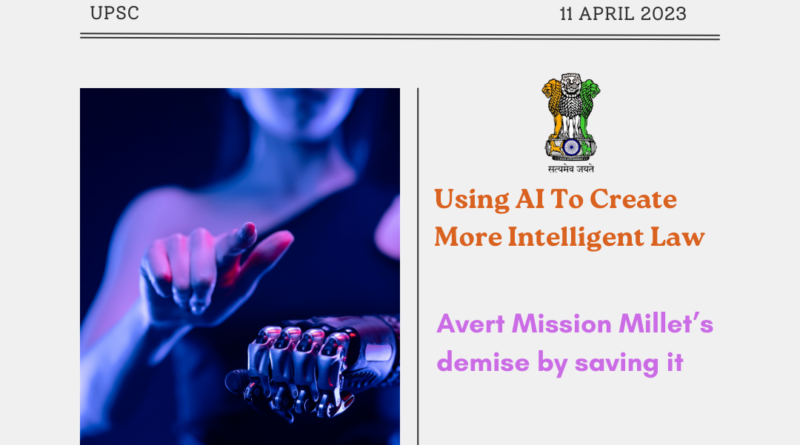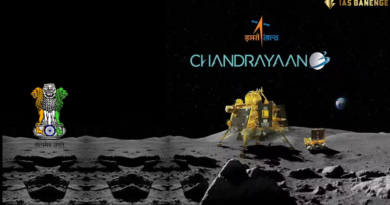Editorials/Opinions Analysis For UPSC 11 April 2023 Ias Banenge
Editorials/Opinions Analysis For UPSC 11 April 2023
Contents
1) Using AI To Create More Intelligent Law
2) Avert Mission Millet’s demise by saving it
Using AI To Create More Intelligent Law
Context:
Artificial intelligence (AI) has become a technology that is changing the game in recent years, grabbing the attention of businesspeople, politicians, and policymakers everywhere.
Relevance:
GS Paper-2: Parliament and State Legislatures.
GS Paper -3: Awareness in the fields of IT, Space, Computers, and robotics
Mains Question
Talk about the moral and legal issues raised by the incorporation of AI into the legislative process. How can these worries be addressed in order to guarantee that the use of AI is promoted in a clear, open, and citizen-friendly way? (250 Words).
Important Points
- The majority of developed democracies now use AI tools to improve parliamentary processes and legislation.Legislative and parliamentary processes are among the many applications where AI tools have become indispensable.
- Improving the quality of research: AI tools can assist legislators in their research on a variety of legislative topics. AI can offer insightful information that can help in the creation of useful policies by analysing vast amounts of data and spotting patterns and trends.
- Providing information on bills and House rules: AI tools can provide details on any bill and aid lawmakers in comprehending how proposed legislation will affect the Indian population.
- Aiding in the drafting of legislation: AI tools can help draught legislation by generating text based on pre-established rules and criteria. This can hasten the drafting process and improve its accuracy.
- Examining media opinions and citizen complaints: AI tools can be used to examine media opinions and citizen complaints to identify problems that require immediate attention. Legislators can use this to prioritise their constituents’ issues and stay in touch with them.
- Simulating potential policy outcomes: AI tools can be used to model a variety of datasets, including the Census, information on household consumption, taxpayers, those who have benefited from different programs, and public infrastructure. This can be used to forecast possible policy outcomes and to find out which laws need to be updated because they are out of date.
There are several difficulties when using AI tools for legislative activities.
- Ethical Issues:
- Bias and discrimination: If the data used to train the algorithms is biased, the algorithms themselves may perpetuate bias and discrimination.
- For instance, AI tools may discriminate against marginalised groups by having a disproportionately negative impact on them.
- Privacy: AI tools have the potential to collect private information, resulting in privacy violations.
- The possibility of monitoring and surveillance can cause people to wonder whether the state is abusing its power.
- Accountability: AI tools may be cryptic and challenging to comprehend. Attributing accountability for decisions made by AI tools can be difficult.
- Accountability systems are required to make sure that AI tools aren’t used to violate human rights.
- Legal issues:
- Liability: It can be challenging to establish responsibility in the event that AI tools cause harm or damage.
- Legal issues:
- The existing legal systems are insufficient to address the liability concerns raised by AI.
- Intellectual property: Since AI can produce content like images, music, and texts, concerns over intellectual property rights have been raised.
- To address the ownership and protection of AI-generated content, legal frameworks are required.
- Regulatory frameworks: It’s possible that the current legal frameworks are insufficient to control how AI is used during the legislative process.
- Regulatory frameworks are required to address the moral and legal issues raised by AI.
Methods for Resolving Ethical and Legal Issues:
- Transparent and Explainable AI: The use of transparent and explainable AI tools can resolve issues with accountability, bias, and discrimination.
- To ensure accountability, AI systems must be transparent and their decision-making process should be clear.
- Data privacy: o Data privacy laws can help ensure that AI tools don’t infringe on people’s right to privacy.
- Individuals must give their consent and anonymize the data used to train AI algorithms.
- Regulatory frameworks: To regulate the use of AI in the legislative process, regulatory frameworks must be established.
- These frameworks must address the moral and legal issues raised by artificial intelligence.
- Liability: Frameworks for determining liability in the event that AI tools cause harm must be established.
- Examples of this could be setting up insurance plans for AI tools and developing a legal framework to handle liability concerns.
- Collaboration: o Policymakers, legislators, and technology experts working together can guarantee that AI tools are used morally and legally.
- By working together, we can make sure that AI tools are created in a way that respects ethical standards and human rights.
Various Parliaments around the world have taken steps to test out AI-powered assistants:
- The US House of Representatives has implemented an AI tool to automate the process of comparing differences between proposed legislation, proposed amendments, and existing laws.
- The “Speech2Write” system, which “translates” spoken reports into written reports, has been adopted by the Netherlands House of Representatives.This system has automatic speech recognition and editing features that can eliminate filler words, correct grammar, and suggest editing choices.
- Japan’s AI tool aids in the automatic selection of pertinent highlights during parliamentary debates as well as the preparation of responses for its legislature.
- Ulysses, a system of artificial intelligence created in Brazil, promotes openness and public participation.
- The Lok Sabha Secretariat in India has created an AI-powered chatbot called “Sampark Se Samadhan” to respond to MPs’ questions and complaints.
- The National e-Vidhan Application (NeVA) platform, which was introduced by the Indian government, allows for the digitization of all legislative workflows, including the production of Notices, Agenda, Committees, Reports, Bills, Debates, Questions, and so forth.
Conclusion:
The use of artificial intelligence (AI) in the legislative process has the potential to significantly improve the process, but it is crucial to address the AI’s ethical and legal issues to make sure that its use is beneficial to citizens.AI tools can be used ethically and legally if appropriate regulatory frameworks are put in place, transparent and understandable AI is used, and policymakers and technology experts work together.
Avert Mission Millet’s demise by saving it
Context
In order to prevent the millet mission from failing, farmers must be given the tools they need to incorporate millets into food programmes rather than concentrating on “Big Food” interests.
Relevance:
GS Paper-3: Major crops-cropping patterns in various parts of the country, – different types of irrigation and irrigation system storage; issues of buffer stocks and food security
Mains Question
Discuss the strategies that should be employed to reintroduce millets as a mainstream staple and the role that innovation can play in achieving this objective. (150 words).
Important Points:
By urging the United Nations to declare 2023 the International Year of Millets, India has taken the lead in promoting millet consumption.India has recognised the enormous potential of millets in addressing the country’s concomitant nutritional challenges of widespread “hidden hunger” and high cardio-metabolic disease as the world leader in production, research, and innovation of these nutritious grains.However, the methods being used to bring millets back into popular culture are misguided and may fail unless more care and imagination are used right away.
Misplaced Focus:
- The Big Food sector needs to have its focus redirected because it is in the wrong place. • However, it is counterproductive to encourage the production of ultra-processed millet-based products by offering sales-based incentives through the Ministry of Food Processing Industries’ Production Linked Incentive Scheme for Millet-Based Products (PLISMBP). Food industry conglomerates like Britannia, Hindustan Unilever, and others have started developing a range of packaged biscuits, breakfast cereals, etc.
- The purpose of this programme is to encourage the food industry to produce ready-to-eat and ready-to-cook millet-based products.
- Unfortunately, promoting the use of millets does not involve ultra-processed millet-based products.
- Due to the extensive nutrient content removal caused by the industrial processing methods used to create these products, they may even be harmful.
- To increase the product’s palatability and extend shelf life, ultra-processed foods frequently contain additional sugar, salt, fat, artificial colorants, flavour enhancers, stabilizers, and preservatives.
- Ultra-processed foods are becoming more and more popular in India, among people of all income levels, in both rural and urban areas, and they are linked to an increased risk of obesity, cardiovascular disease, metabolic syndrome, depression, and early mortality. According to one study, ultra-processed foods account for up to 20% of adolescents’ daily caloric intake in Delhi.
- Due to the extensive nutrient content removal caused by the industrial processing methods used to create these products, they may even be harmful.
Prioritizing the Consumer:
- In order to save Mission Millet, India must put the needs and preferences of the consumer first. Millets can be distributed to the general public in a healthier way by small-scale eateries and street vendors.
- The rural population, which deserves a thorough understanding of their dietary requirements and various millet-based products’ approaches, can be served by street vendors’ fresh and less processed foods.
- Another method to include millets in the Indian diet is for the Center to mainstream millets into the pillars of the National Food Security Act.
- According to the Production Linked Incentive Scheme for Millet-Based Products guidelines, millet-based products may be sold if they contain at least 15% millets, but the remaining 85% may still contain refined white flour, hydrogenated fats, sugar, and other additives.
- This indicates that they may be marketed to consumers as healthy foods, which could result in health issues. As a result, it’s important to accurately regulate millet-based product labelling and advertising.
- A lot of new businesses are marketing their products as “clean food,” meaning they don’t contain any artificial ingredients or additives.
- However, their prices are prohibitive, widening the gap between the urban elite and the poor.
- The formerly “poor man’s food” needs to be revived, and encouraging millet consumption should enable farmers to serve the general public.
- Making Healthy Millet-Based Dishes Innovative
- Indian street food has a rich culinary history and gives the general public access to more nutritious millet-based dishes.
- Millets have been neglected for centuries, but thanks to creative street food, their inclusion in the diet of the general public is now possible.
- For instance, street vendors and small eateries may serve puffed jowar bhel, ragi tikki chaat, and bajra ladoos.
- Providing dhaba chefs with recipes and training can be an innovation in millet-based dishes, helping to promote the availability and affordability of millet-based offerings.
Conclusion :
- It will take consideration and innovation to make millets once again a popular staple in India.
- To make millet-based products accessible to the general public, India needs to refocus on healthy alternatives to ultra-processed millet-based products and invest in small-scale food establishments and street vendors.
- To prevent health issues, regulating millet-based product advertising and labelling should be a top priority.
- By empowering farmers to meet the dietary needs of the general public and promoting traditional methods, India needs to innovate in millet-based dishes.
- To make millet-based products accessible to the general public, India needs to refocus on healthy alternatives to ultra-processed millet-based products and invest in small-scale food establishments and street vendors.
- The reintroduction of millets into the Indian diet can be successful if these tactics are used.




